top of page

PHILIPS SLEEP CHALLENGE
This 5-week challenge hosted by Philips tasked us with developing a solution to improve sleep among teenagers. We designed a solution that creates an ecosystem with parents and schools to encourage teenagers to sleep better.
My Role
MY ROLE
I spearheaded the project by creating a framework for the solution development process.
This included defining a strategy for the exploration of the problem space, concept generation, down-selection and development of the final solution.
PROBLEM SPACE RESEARCH
I conducted the preliminary research to explore studies that have been conducted into teenage sleep.
This exploration helped the team identify a set of key factors that influenced our foray into stakeholders research through direct interviews and surveys.
STAKEHOLDER RESEARCH
I partnered with 3 of our 5 team members to conduct direct interviews with 2 teenagers and 2 parents.
I made a marked contribution to the creation and distribution of the survey amongst high school students across the country.
STRATEGY & VISION
I led the efforts to develop a holistic solution that would create an ecosystem; seamlessly bringing together the various stakeholders (teenagers, parents and the school administration).
DESIGN EXECUTION
I envisioned and designed the hardware component of our solution. I was careful to ensure that our product was not resource intensive in its development and fit in seamlessly into the Philips product lineup without cannibalizing any existing products.
LEADERSHIP & COORDINATION
From guiding our team through a timeline of activities to presenting our work to senior executives at Philips, I took on responsibilities where ever the opportunity arose.
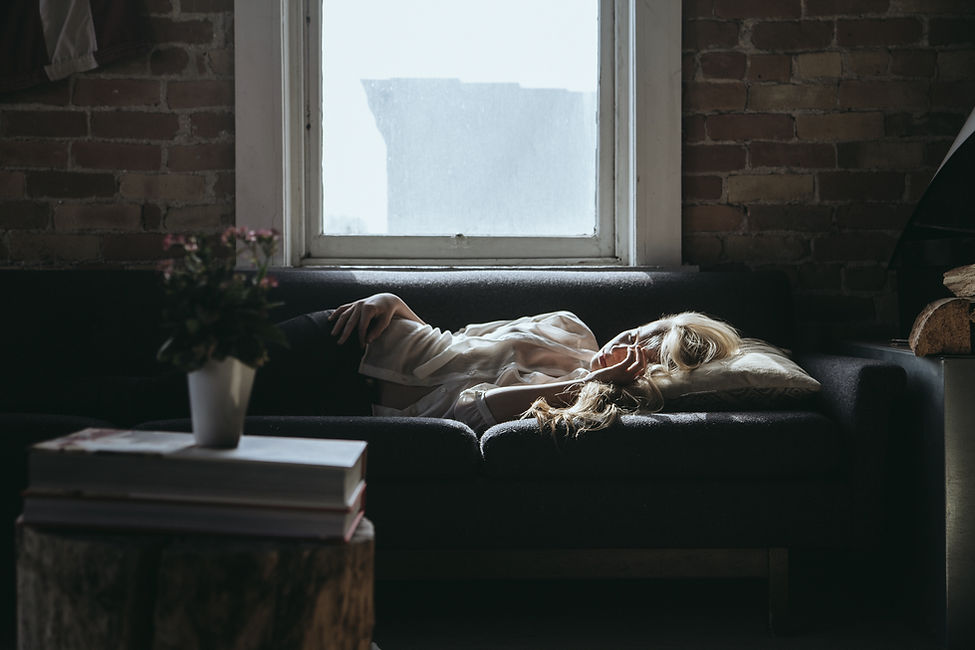
Problem Statement
THE CHALLENGE
IMPROVE TEENAGE SLEEP
The median amount of teenage sleep has reduced from 7.75 hours in 1969 to 6.65 hours in 2001. For teenagers, each hour of lost sleep has been associated with a 38% increase in depression, a 42% of increase in considering suicide and a 23% increase in substance abuse. Studies suggest that 87% of American high school students are chronically sleep deprived.
Our goal with this project was two fold. One, raise the awareness of sleep among teens and two, help improve the length and quality of sleep among teens.
The high level goals as defined by Philips were:
-
The solution be integratable within Philips’ existing portfolio of sleep products
-
The solution be customizable and tailored specifically towards teenagers

Solution Approach
THE APPROACH
BUILD SYSTEMIC SOLUTION
With longevity of Philips’ profitability at the core, we decided to chase the development of a systemic solution that would bring together hardware and software in the most effective manner. This tactic was identified as the most effective and least risky in terms of solution resilience. Our strategy then, was to develop a holistic solution that would leverage the various stakeholders (teens, parents and schools) to provide the most potent solution.
DISCOVER-DEFINE-DEVELOP
The solution development process was broken down into two phases. The first phase involved developing a detailed understanding of the problem space. This would allow for the definition of the root cause of the problem enabling the creation of an effective solution. In the second phase, a number of concepts were generated through exploratory ideation exercises. A final solution was then developed by identifying the key strengths of the top concepts as selected by the team.
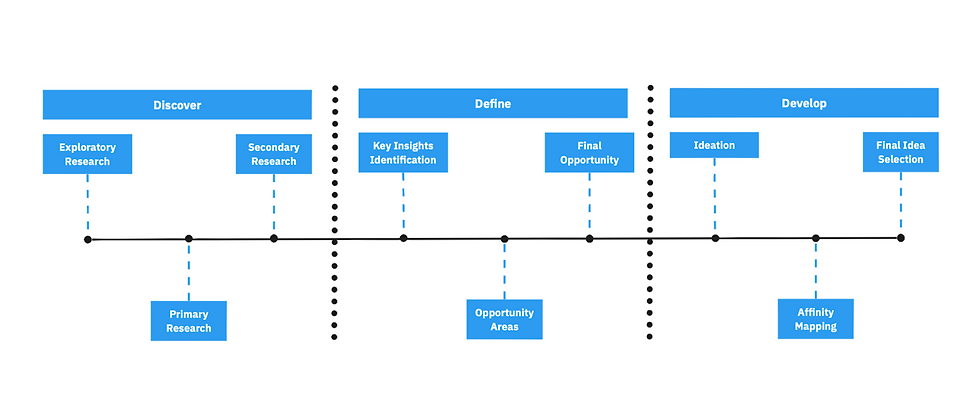
User Research
THE DISCOVERY
We mapped the key stakeholders before conducting user research. We then conducted research with all the stakeholders. Through the mapping exercise, we were able to ask the right questions to the right people.

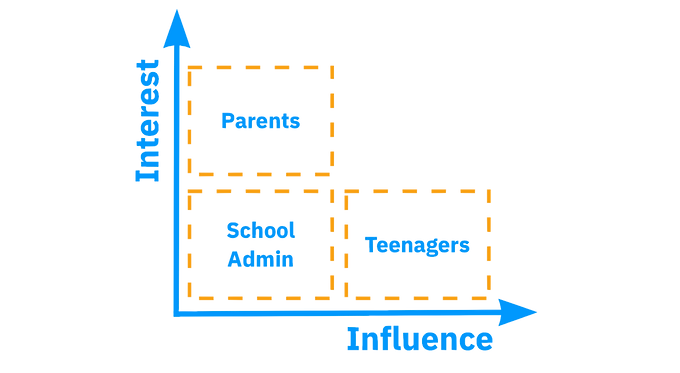
STAKEHOLDER RESEARCH
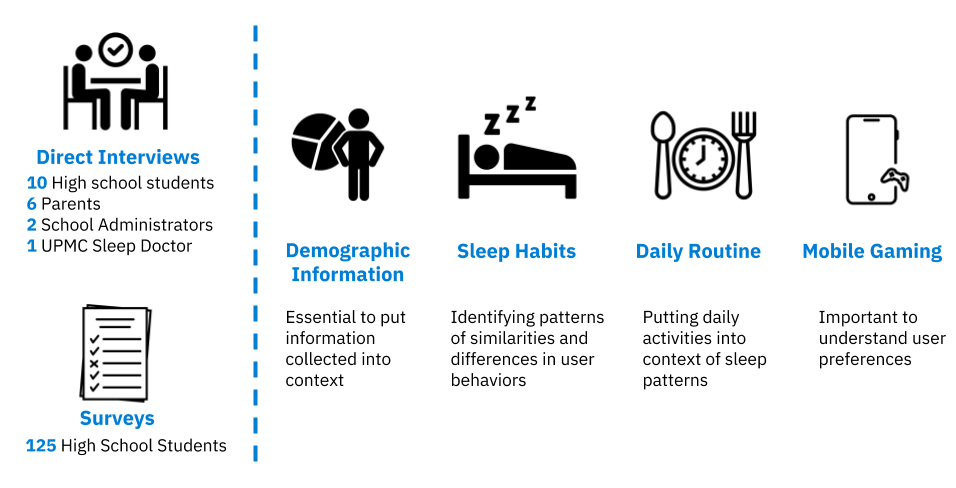
KEY INSIGHTS
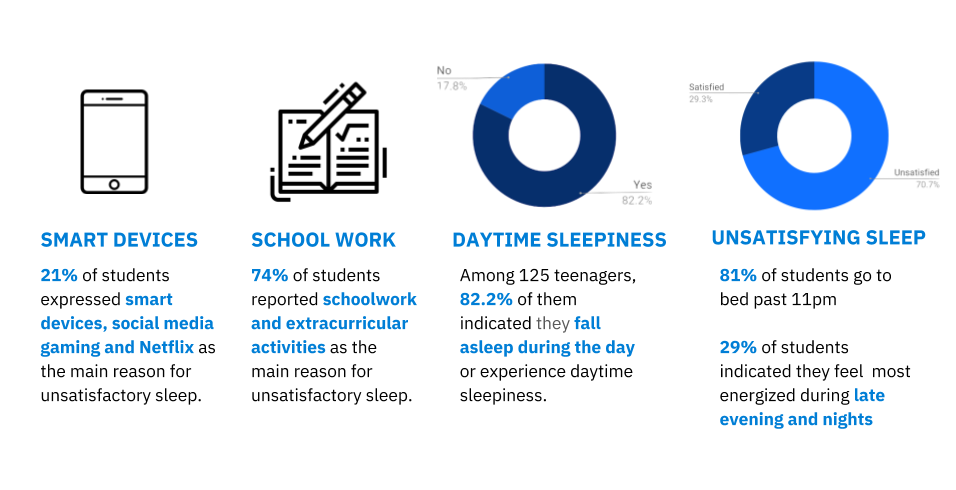
Empathy Map
EMPATHY MAP

JOURNEY MAP
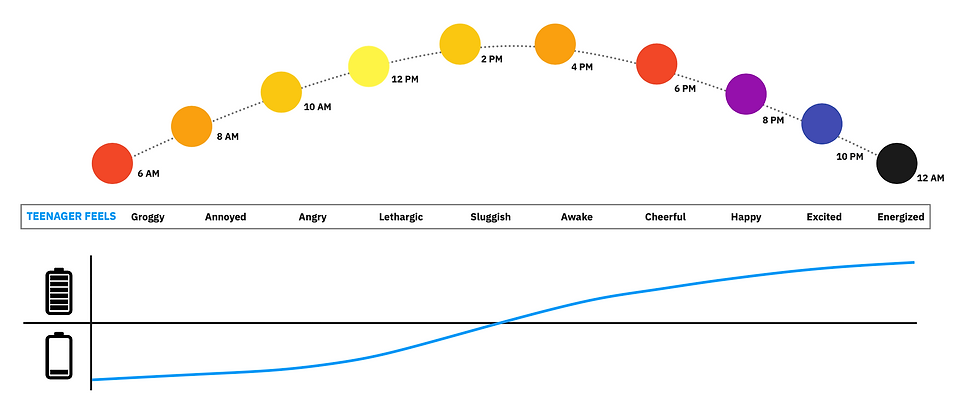
Journey Map
Ideation
BRAINSTORMING
We conducted two 10-minutes ideation sprints to generate a number of ideas. The first sprint involved thinking about ways and means to build awareness of the importance of sleep in teenagers. The second sprint had the team ideate on methods to encourage sleep among teenagers. The ideas thus generated were affinity grouped based on compatibility of function before two rounds of dot-voting were used to facilitate the downselection process.


THE AHA MOMENT
It was during a team discussion about two ideas that might improve teenagers’ sleep quality, that we realized that teenagers do not value sleep, not do they understand its importance. Since, their bodies are naturally prone to reduced sleep, they do not see the adverse effects in their mood and behavior. Therefore, it did not matter how good our solution was; what mattered was that we incentivized teenagers to WANT to sleep.
“Irrespective of the solution, there is no incentive for a teenager to sleep more”
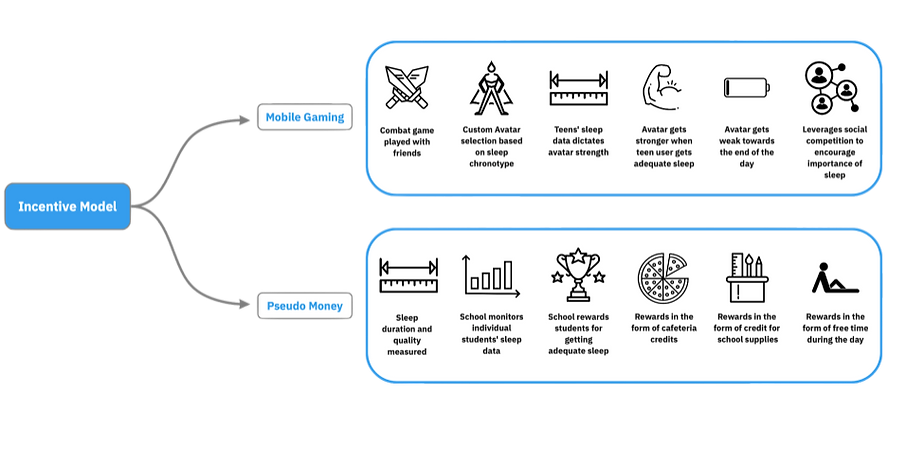
Hardware
HARDWARE COMPONENT: SNOOZE
Designed to be a bedside lamp, Snooze serves as a transition zone from the smartphone to bed. Inspired by the light therapy solution of Philips Somneo, users control the intensity and temperature of light to help create a customized optimal sensory experience for sleep. Using an array of microphones and thermal imaging cameras, Snooze accurately tracks teens’ sleep duration and quality.
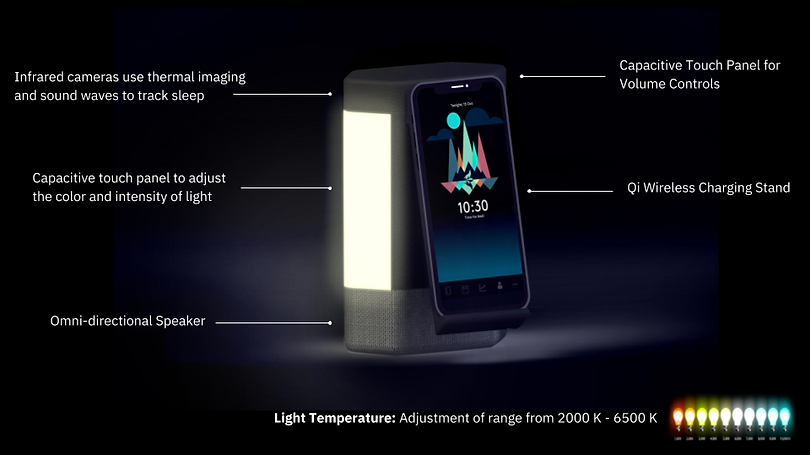

Software
SOFTWARE COMPONENT: TEENAGERS
The software component has three editions: one for the teenagers, one for the school administration and one for the parents.
The teenagers edition is a mobile application with two sections: the game and the dashboard.
The game section allows teenagers to select their own custom avatar and then use these avatars in combat with their friends. The avatars are programmed to reflect the energy levels in the teenager’s body. If a teenager gets adequate sleep, the avatars will be strong in the morning and will gradually weaken by night time. If the teenager sleeps less, the avatar transforms into a weakened being unable to combat effectively.
The dashboard section provides teen with all the information relevant to their sleep such as the sleep duration, quality, disturbances, snoring etc. Further, the dashboard allows teens to set a soothing alarm on the hardware component and input their mood upon waking up in the morning. Teenagers can also view their accumulate rewards points.



Credit: Chi-Chi Bello
System Design
NETWORK DESIGN
Our solution would adopt a Business to Business (B2B) model. We propose the creation of a network of high schools all centered around Philips. Philips would sell the hardware to schools in bulk at discounted rates. Schools can then sell the hardware to teenagers at a premium cost, thereby monetarily incentivizing schools.
Similarly, Philips will sell a data management system to the schools for monitoring the student’s sleep data. The teenagers’ sleep data will be encrypted with schools getting access to individual sleep data of each student while Philips will have access restricted to trend data of each school. This trend data should be invaluable to Philips as it is essentially real-time user research data that can be used for new product development.
NETWORK DESIGN
Our solution would adopt a Business to Business (B2B) model. We propose the creation of a network of high schools all centered around Philips. Philips would sell the hardware to schools in bulk at discounted rates. Schools can then sell the hardware to teenagers at a premium cost, thereby monetarily incentivizing schools.
Similarly, Philips will sell a data management system to the schools for monitoring the student’s sleep data. The teenagers’ sleep data will be encrypted with schools getting access to individual sleep data of each student while Philips will have access restricted to trend data of each school. This trend data should be invaluable to Philips as it is essentially real-time user research data that can be used for new product development.
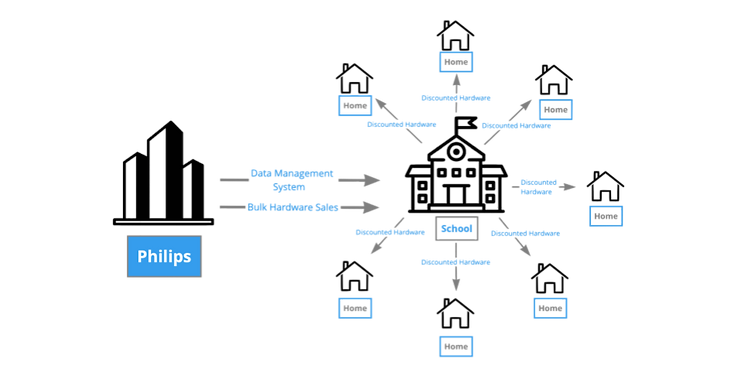
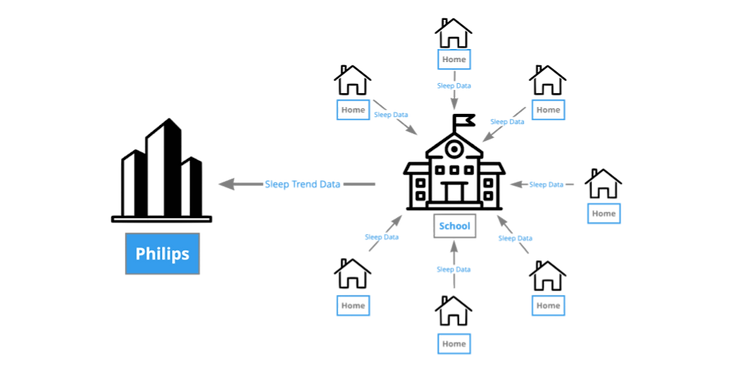
REVENUE MODEL
Our solution chiefly utilizes hardware and software sales to earn revenue. Pricing for the hardware component is kept at $130. This amount was decided based on an estimated manufacturing cost of $70. The pricing for the software was made competitive to the existing SaaS learning management systems. The revenue from different high school categories is based on penetration rates.

Value Proposition
VALUE PROPOSITION
As with any solution, it is essential to view the effect on every stakeholder. We attempt to ensure that a positive value is added at each stage of our solution.
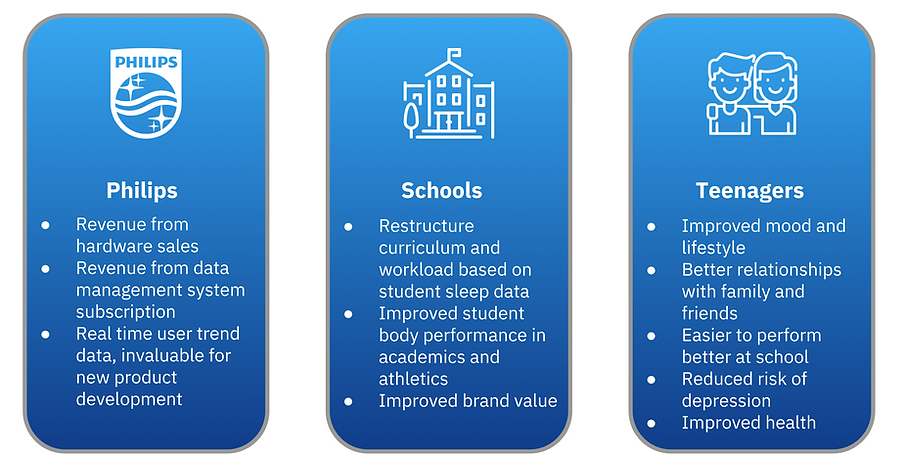
My Learning
WHAT DID I LEARN ?
This challenge exposed me to the very REAL problem of teens not getting adequate sleep and the detrimental effects that this can have on their lives and of those around them.
In conducting user research, I learnt the value of identifying the relevant stakeholders prior to conducting research. This helped us structure our research more efficiently, which was crucial given the fast paced nature of this challenge. In developing solutions, I learnt to keep the target user at the core of the ideation process. It was this step that helped us identify the need for an incentive model over any other solution in regards to teenage sleep.
Working in an interdisciplinary team of engineers, designers and business students, allowed me the opportunity to sharpen my leadership skills by structuring the work, optimally using design thinking activities and minimize intra team conflicts. As the sole presenter, I was able to enhance my presentation skills in making an official presentation to senior executives at Philips.
bottom of page
